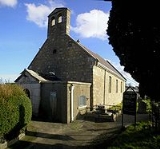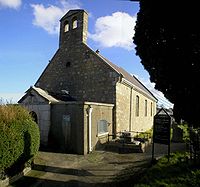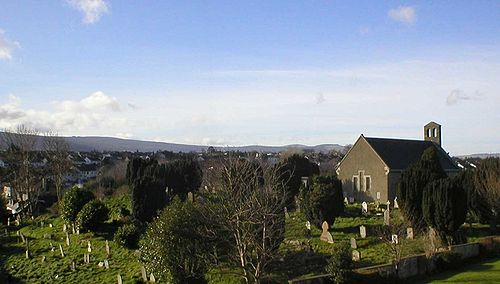
St. Nahi's Church
Encyclopedia

Dundrum, Dublin
Dundrum , originally a town in its own right, is now a suburb of Dublin in Dún Laoghaire-Rathdown, Ireland.The area is located in the postal districts of Dublin 14 and Dublin 16.-History:...
, Ireland
Ireland
Ireland is an island to the northwest of continental Europe. It is the third-largest island in Europe and the twentieth-largest island on Earth...
.
History
The name Taney derives from Tigh Naithi meaning the house or place of Nahi, and who may also be associated with Tobarnea, a seashore well that near Blackrock. The current church is still in use by the local Church of IrelandChurch of Ireland
The Church of Ireland is an autonomous province of the Anglican Communion. The church operates in all parts of Ireland and is the second largest religious body on the island after the Roman Catholic Church...
community and is one of two churches in the Parish of Taney
Taney Parish
Taney is a populous parish in the Church of Ireland, located in the Dundrum area of Dublin.-Early history:Taney's origins go back to the early Irish saint Nathi, who in the 6th century established a centre for monastic life. This centre may have been on what is now the site of St. Nahi's Church in...
(historically encompassing the whole area around Dundrum). It is built on the site of an early Irish monastery founded by Saint NahÍ
Nath Í of Cúl Fothirbe
Saint Nath Í or Nathí , also anglicised to Nathy, was an early Irish saint of the Dál Messin Corb, who was credited with the foundation of Cúl Fothirbe in Dál nAraide territory and with becoming its first bishop. He is not be confused with Nath Í, bishop and founder of Sruthair Guaire Saint Nath Í...
.
St. Nahi's stands on the grounds of the original monastery, having been refurbished several times, most recently in 1910, after a period when it was in use as the local boys' national school. Following storm damage to the roof, a major refurbishment was carried out by the then Rector of the Parish, Canon William Monk Gibbon (father of the poet
Monk Gibbon
William Monk Gibbon was an Irish poet and prolific author, known as "The Grand Old Man of Irish Letters". His collection of over twenty volumes of poetry, autobiography, travel and criticism are kept at Queen's University Belfast. He also wrote many published novels, and has been characterised as...
of the same name), who is buried in the grounds of the church. A plaque erected after the refurbishment reads:
Items of interest
The church contains some interesting artefacts including the baptismal fontBaptismal font
A baptismal font is an article of church furniture or a fixture used for the baptism of children and adults.-Aspersion and affusion fonts:...
of the Duke of Wellington
Arthur Wellesley, 1st Duke of Wellington
Field Marshal Arthur Wellesley, 1st Duke of Wellington, KG, GCB, GCH, PC, FRS , was an Irish-born British soldier and statesman, and one of the leading military and political figures of the 19th century...
who was baptised in 1769, donated to Taney Parish in 1914 by the closing of St. Kevin’s Church in Camden Row, and altar tapestries depicting scenes from the Bible. The tapestries illustrating the Last Supper were made by the two Yeats sisters Lily and Lolly Yeats
Elizabeth Yeats
Elizabeth Corbett Yeats , known as Lolly, was born at 23 Fitzroy Road, London. She was the daughter of the Irish artist John Butler Yeats and sister of W. B., Jack and Susan Mary "Lily" Yeats. She trained and worked as an art teacher and was a member of William Morris's circle in London before her...
, both of whom are interred in the graveyard.
Two Rathdown Slabs are displayed inside the church. These ornate burial slabs date back 1,000 years to the Viking
Viking
The term Viking is customarily used to refer to the Norse explorers, warriors, merchants, and pirates who raided, traded, explored and settled in wide areas of Europe, Asia and the North Atlantic islands from the late 8th to the mid-11th century.These Norsemen used their famed longships to...
-Christian era. Such slabs have only been found in the barony of Rathdown (the area roughly covering Churchtown
Churchtown, Dublin
Churchtown is a largely residential suburb on the southside of Dublin, Ireland, between Dundrum and Rathfarnham. It is in the postal districts Dublin 14 and Dublin 16.- Ely's Arch :...
to Bray
Bray
Bray is a town in north County Wicklow, Ireland. It is a busy urban centre and seaside resort, with a population of 31,901 making it the fourth largest in Ireland as of the 2006 census...
). Only about 30 of these slabs have been discovered to date, these two were discovered in 2002 in the graveyard by archaeologist Chris Corlett, who had missed his bus from Dundrum and decided to explore the cemetery. . Aided by Dúchas
Dúchas
Dúchas – The Heritage Service was the Irish State body responsible for national monuments and historic properties. It was established under the Heritage Act 1995 and took over responsibility for the management of national parks and wildlife from the Office of Public Works...
, the slabs were relocated inside the church.
An insight into life expectancy for the area can be gleaned from the "Index to the Register of Burials" for the parish between January 1897 and April 1917 show 1,836 people buried during this period, of which 551 were children under 6 years of age.

Graveyard
Cremated remains are interred to the left of the entrance gates. This area was originally a mass famine grave and later used for patients of the Dundrum Central Mental Hospital. Old records refer to this area as the Asylum Plot.A back gate to the church was only recently uncovered under much overgrowth. Although it had been used by teachers as a shortcut between the Church (when it was being used as a boys national school) and the nearby girls national school, its original function is said to have been as an entrance for Roman Catholics when attending funerals at a time when they were barred from entering the main gates of a Protestant church.
Many Irish Republican
Irish Republicanism
Irish republicanism is an ideology based on the belief that all of Ireland should be an independent republic.In 1801, under the Act of Union, the Kingdom of Great Britain and the Kingdom of Ireland merged to form the United Kingdom of Great Britain and Ireland...
graves lie within the graveyard, including the gravestones of Lorcain McSuibhne, a member of the Irish Republican Army
Irish Republican Army
The Irish Republican Army was an Irish republican revolutionary military organisation. It was descended from the Irish Volunteers, an organisation established on 25 November 1913 that staged the Easter Rising in April 1916...
killed in 1922 in Kildare
Kildare
-External links:*******...
(his funeral occurred at St. Nahi's and there exists photographic evidence of Éamon de Valera
Éamon de Valera
Éamon de Valera was one of the dominant political figures in twentieth century Ireland, serving as head of government of the Irish Free State and head of government and head of state of Ireland...
in attendance) and of James Burke, who was killed in Croke Park
Croke Park
Croke Park in Dublin is the principal stadium and headquarters of the Gaelic Athletic Association , Ireland's biggest sporting organisation...
on Bloody Sunday
Bloody Sunday (1920)
Bloody Sunday was a day of violence in Dublin on 21 November 1920, during the Irish War of Independence. In total, 31 people were killed – fourteen British, fourteen Irish civilians and three republican prisoners....
. There is also a 1798 plot where some fatalities of the 1798 uprising are buried.
The graveyard also contains many Royal Irish Constabulary
Royal Irish Constabulary
The armed Royal Irish Constabulary was Ireland's major police force for most of the nineteenth and the early twentieth centuries. A separate civic police force, the unarmed Dublin Metropolitan Police controlled the capital, and the cities of Derry and Belfast, originally with their own police...
Officers and Freemasons. Just one casualty of the Second World War is recorded there. Sgt. William Anthony Kavanagh, RAF Volunteer Reserve, age 24, died 23 sept 1944, son of William and Mary Kavanagh of Dundrum. The site also contains the grave of the Irish physicist George Johnstone Stoney
George Johnstone Stoney
George Johnstone Stoney was an Irish physicist most famous for introducing the term electron as the "fundamental unit quantity of electricity"....
, who was a long time Dundrum resident and who gave his name to the nearby Stoney Road.
Currently over 10,000 burials have been recorded, with the earliest visible gravestone dating back to 1734. The Parish of Taney: a History of Dundrum, Near Dublin, and its Neighbourhood published in 1895, claims that there are “tens of thousands” of burials within the graveyard, a credible figure considering its age.
As the churchyard predates the disestablishment of the Church of Ireland in 1869, it is open for burial to all those who live within the boundaries of the Parish
Parish
A parish is a territorial unit historically under the pastoral care and clerical jurisdiction of one parish priest, who might be assisted in his pastoral duties by a curate or curates - also priests but not the parish priest - from a more or less central parish church with its associated organization...
of Taney, whatever their denomination.

